The NVIDIA GeForce GTX 750 Ti and GTX 750 Review: Maxwell Makes Its Move
by Ryan Smith & Ganesh T S on February 18, 2014 9:00 AM ESTOverclocking: When Headroom Exceeds Clockspeed Limits
Last but not least we have our customary look at overclocking performance. With all 3 of our cards being based on the same reference design, we expect to see some relatively consistent results between the cards. At the same time NVIDIA has told us that GTX 750 has some very interesting overclocking properties, and boy they weren’t kidding.
On a quick note, as a GPU Boost 2.0 product, overclocking on the GTX 750 series is not any different than on other GTX 700 series cards. It’s still based on offset overclocking, with the user adjusting offsets for the final overclock. But with that said there are two things to point out. The first is that the power target is limited to 100% on all cards. Because these are sub-75W cards, NVIDIA is not allowing anyone to exceed the card’s default TDP, so you only have as much power to play with as you started with. Second of all, none of our cards had available overvoltage bins. Apparently some cards do, but ours did not, so our voltage bins maxed out at the default bins you see listed.
Finally, all 3 cards have a maximum clock offset of 135MHz. This will be an important fact in a little bit.
| GeForce GTX 750 Series Overclocking | |||||
| GTX 750 Ti (Ref) | Zotac GTX 750 Ti | Zotac GTX 750 | |||
| Shipping Core Clock | 1020MHz | 1033MHz | 1033MHz | ||
| Shipping Max Boost Clock | 1150MHz | 1175MHz | 1163MHz | ||
| Shipping Memory Clock | 5.4GHz | 5.4GHz | 5.0GHz | ||
| Shipping Max Boost Voltage | 1.168v | 1.137v | 1.187v | ||
| Overclock Core Clock | 1155MHz | 1168MHz | 1168MHz | ||
| Overclock Max Boost Clock | 1285MHz | 1310MHz | 1298MHz | ||
| Overclock Memory Clock | 6.3GHz | 6.1GHz | 6.0GHz | ||
| Overclock Max Boost Voltage | 1.168v | 1.137v | 1.187v | ||
As we can quickly see, two patterns emerge. The first is that with every card equipped with 6GHz memory (though we remain unsure which mode the Zotac GTX 750’s is in), each and every card hits at least 6GHz, and sometimes a bit more. With the 128-bit memory bus generally providing the biggest bottleneck for GM107, the fact that there is 12%+ overclocking headroom here is going to be very helpful in feeding the tiny beast that is GM107.
More significantly however is the core overclock. We maxed out every single one. Every card, from the NVIDIA reference card to the Zotac cards, had no trouble overclocking by the full 135MHz to their respective maximum overclocks. The Zotac GTX 750 Ti, having the highest maximum boost clock by default, is technically the winner here at 1310MHz. But at this point everyone is a winner. Going by the maximum boost clock, every card is capable of an 11% core overclock, to go with that tasty 12% memory overclock.
The fact of the matter is that this is not something we normally encounter. Sub-75W cards are not poor overclockers, but they’re not usually strong overclockers either, which is why a 135MHz offset limit makes sense at first glance. But it’s clear that NVIDIA underestimated their own overclocking potential here when setting the specifications for these cards, as there’s seeming some headroom left untapped. Without additional offset room it’s impossible to say just how much more overclocking headroom remains – it may not be very much – but there should be room for at least some additional overclocking.
At this point with cards already in the pipeline we’ll have to take a look at individual cards and see what manufacturers have set their offset limits at. If they have followed NVIDIA’s specifications, then they’ll be equally limited. But hopefully with the launch now behind them, NVIDIA’s partners can work with NVIDIA on making greater offsets available on newer batches of cards.
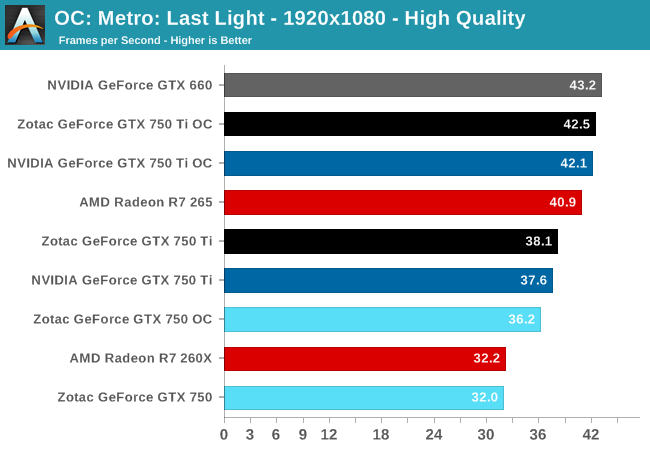
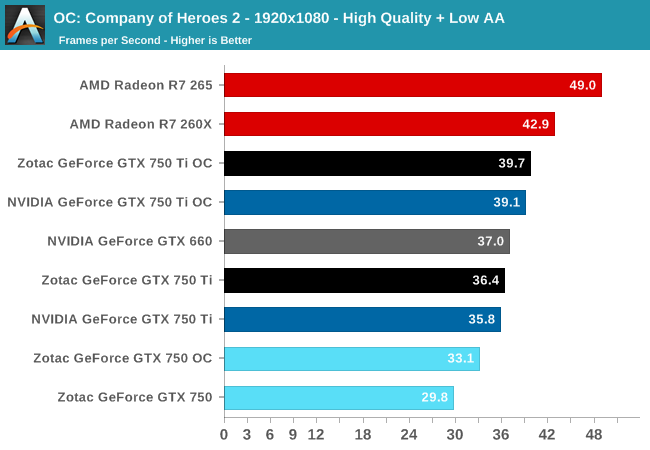
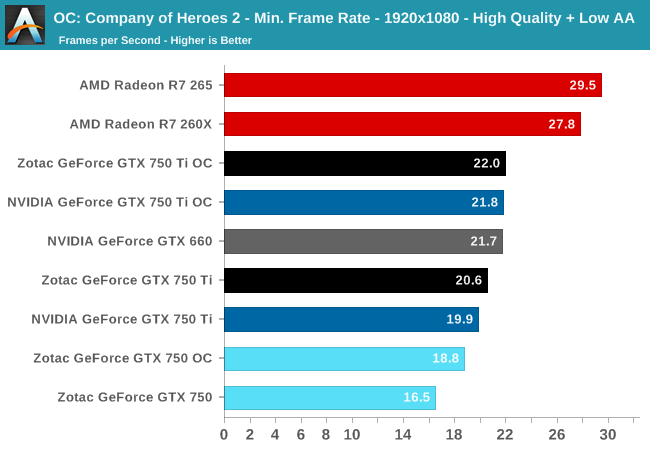

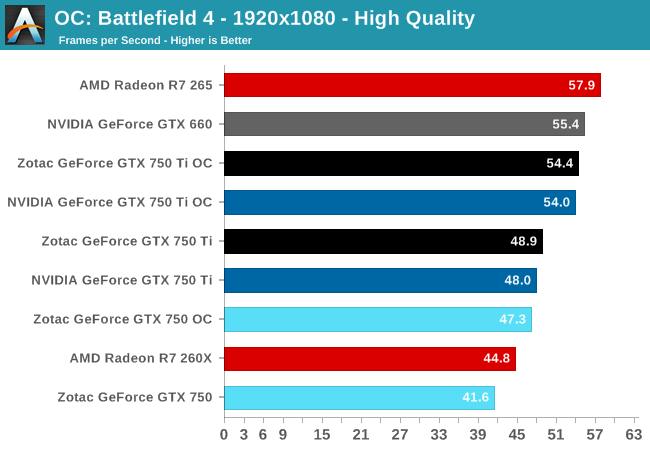
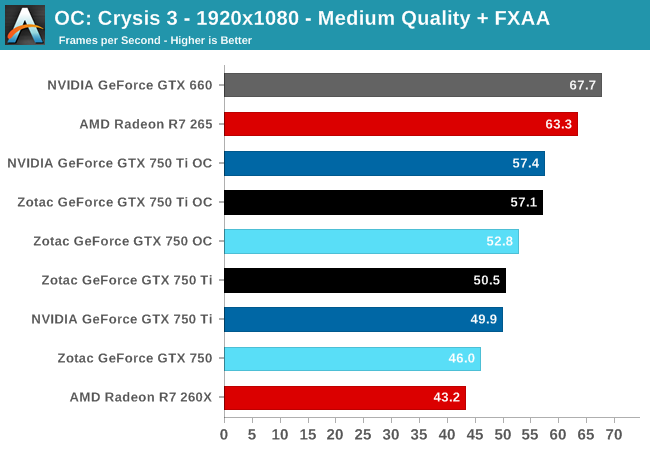
Depending on the game being used, the benefits from overclocking range from 9% to 12%, roughly in-line with our overclocks. For the GTX 750 this is sometimes enough to catch the stock clocked R7 260X, but even with this overclock the GTX 750 Ti will still generally trail the R7 265.
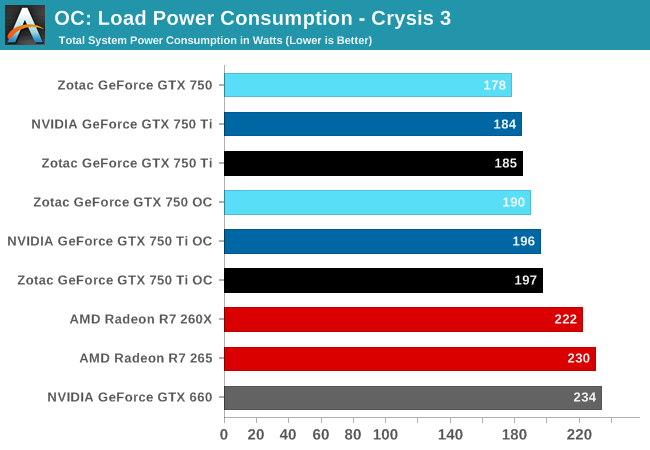

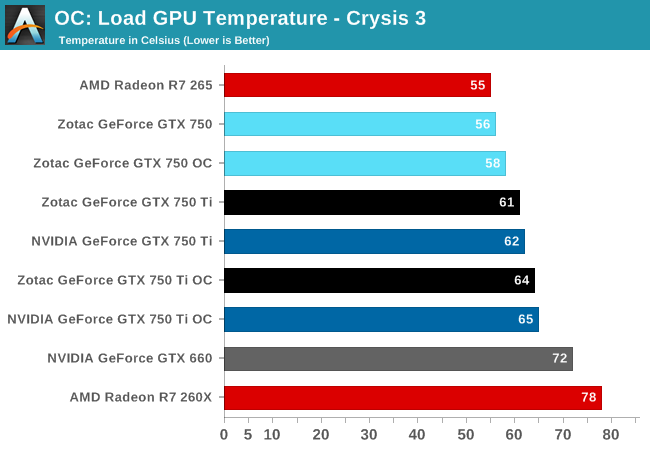
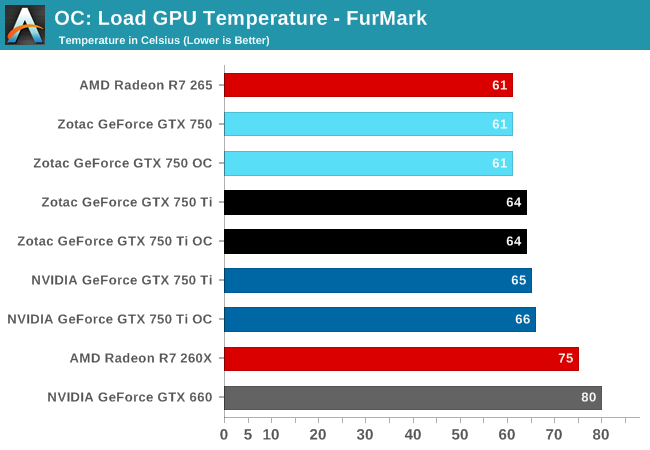
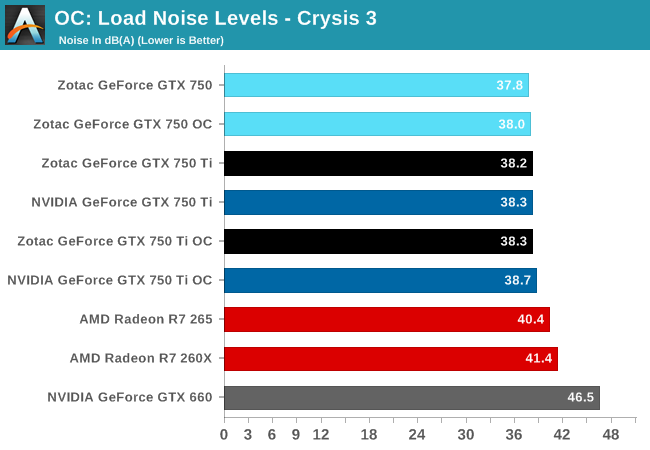
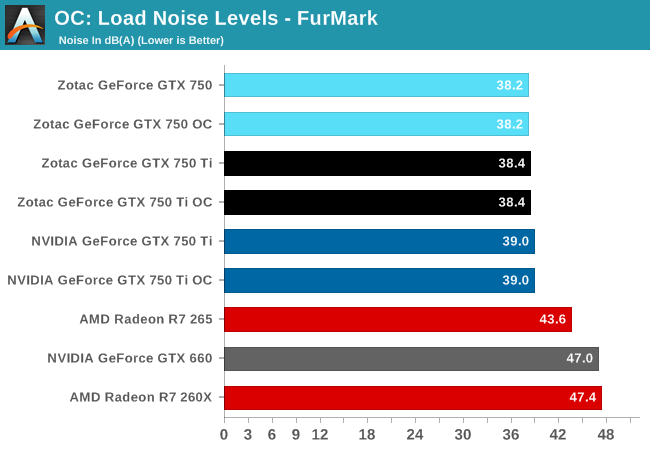
On the other hand, because of the hard TDP limit of 100%, this extra performance is relatively cheap. Video card power consumption moves by only a few watts, and then a few watts of CPU time on top of that. For all practical purposes overclocking can extend NVIDIA’s already incredible performance-per-watt ratio by another 10% with no meaningful impact on noise. Given the consistency of overclocking headroom we’ve seen in our GTX 750 series samples, this is one of those scenarios where overclocking is going to be a reasonable and (relatively) fool proof action to take.










177 Comments
View All Comments
kwrzesien - Tuesday, February 18, 2014 - link
Seems coincidental that Apple is going to use TSMC for all production of the A8 chip with Samsung not ready yet, maybe Apple is getting priority on 20nm? Frankly what nVidia is doing with 28nm is amazing, and if the yields are great on this mature process maybe the price isn't so bad on a big die. Also keep in mind the larger the die the more surface area there is to dissipate heat, Haswell proved that moving to a very dense and small die can create even more thermal limitations.DanNeely - Tuesday, February 18, 2014 - link
Wouldn't surprise me if they are; all the fab companies other than Intel are wailing about the agonizingly high costs of new process transitions and Apple has a history of throwing huge piles of its money into accelerating the build up of supplier production lines in trade for initial access to the output.dylan522p - Tuesday, February 18, 2014 - link
Many rumors point to Apple actually making a huge deal with intel for 14nm on the A8.Mondozai - Wednesday, February 19, 2014 - link
Maybe 14 for the iPhone to get even better power consumption and 20 for the iPad? Or maybe give 14 nm to the premium models of the iPad over the mini to differentiate further and slow/reverse cannibalization.Stargrazer - Tuesday, February 18, 2014 - link
So, what about Unified Virtual Memory?That was supposed to be a major new feature of Maxwell, right? Is it not implemented in the 750s (yet - waiting for drivers?), or is there currently a lack of information about it?
A5 - Tuesday, February 18, 2014 - link
That seems to be a CUDA-focused feature, so they probably aren't talking about it for the 750. I'm guessing it'll come up when the higher-end parts come out.Ryan Smith - Thursday, February 20, 2014 - link
Bingo. This is purely a consumer product; the roadmaps we show are from NV's professional lineup, simply because NV doesn't produce a similar roadmap for their graphics lineup (despite the shared architecture).dragonsqrrl - Tuesday, February 18, 2014 - link
"Meet The Reference GTX 750 Ti & Zotac GTX 750 Series""This is the cooler style that most partners will mimic, as the 60W TDP of the GTX 650 Ti does not require a particularly large cooler"
You mean 750 Ti right?
chizow - Tuesday, February 18, 2014 - link
The performance and efficiency of this chip and Maxwell is nothing short of spectacular given this is still on 28nm. Can't wait to see the rest of the 20nm stack.Ryan, are you going to replace the "Architectural Analysis" at some point? Really looking forward to your deep-dive on that, or is it coming at a later date with the bigger chips?
dgingeri - Tuesday, February 18, 2014 - link
In the conclusion, the writer talks about the advantages of the AMD cards, but after my experiences with my old 4870X2, I'd rather stick with Nvidia, and I know I'm not alone. Has AMD improved their driver quality to a decent level yet?